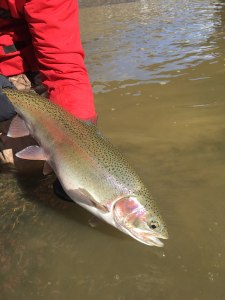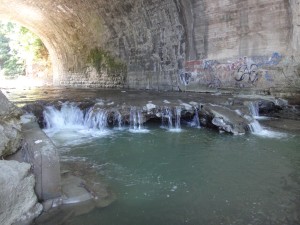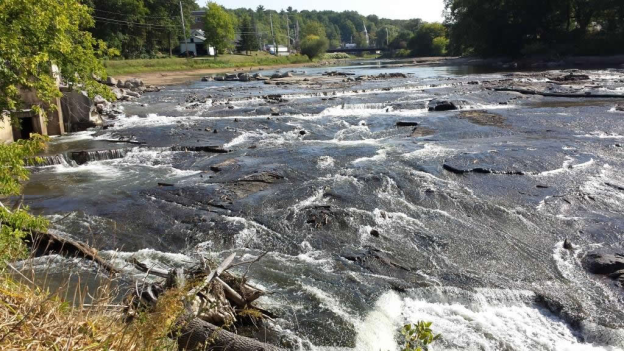Today’s blog was co-written by Catherine Gatenby and Betsy Trometer, fish biologists at Lower Great Lakes Fish and Wildlife Conservation Office. Visit them on Facebook
Chautauqua Creek emerges out of the slate bedrock and gravel of western New York and flows 15 miles north and west, emptying into Lake Erie about 50 miles south of Buffalo, New York. It’s among one of the top steelhead fisheries in the entire state because of the amount of public access, with anglers catching as many as 1 to 2 steelhead per hour. New York presently maintains 8.5 miles of public fishing easements on Chautauqua Creek, including 1.3 miles of catch and release with artificial lures just below the Westfield Water Works Dam. The steelhead fishery is supported extensively by the New York State Department of Environmental Conservation (NYSDEC) stocking programs in Lake Erie tributaries.
Historically, Chautauqua Creek had always been perfect habitat for trout. Soldier, lawyer, diplomat, and writer, Mr. Albion W. Tourgee wrote of the Chautauqua in 1887’s Button’s Inn: “From source to mouth there was hardly a hundred yards of quiet water …Heaven grant that the foot of the despoiler may be long delayed, and that the trout which hide in its cool waters may long continue…”
Decades ago, two dams were constructed on the Chautauqua approximately five miles upstream from its mouth at Lake Erie. These dams impeded water flow and limited fish passage and fishing opportunities. Fish and anglers were limited to 5-mile reach between the dams and Lake Erie.
The uppermost dam, the Westfield Water Works Dam, serves to pool water routed to a reservoir used for the public by the village of Westfield. The lower dam no longer serves a purpose. Chautauqua Creek also had been experiencing erosion downstream of a railroad bridge culvert 2 miles upstream from the mouth, which created a drop and another impassable barrier to both migratory and resident fishes like smallmouth bass and white sucker.
But it’s the steelhead trout that bring the anglers to Chautauqua Creek.
Recently, Chautauqua Creek was targeted by state and federal partners, including the Chautauqua Soil and Water Conservation District and Trout Unlimited, for habitat restoration projects that would reduce erosion and boost the recreational fisheries. Funding from the Great Lakes Restoration Initiative and the Great Lakes Fish Habitat Partnership was provided to open more than 10 miles of high quality spawning and nursery habitat for migratory and resident fishes, and increase the amount of angler access to this important recreational fishery. In the summers of 2015 and 2016, rock riffles were repaired at the upper dam, and new rock riffles were constructed at the lower dam and below the railroad bridge to allow fish passage. After 3 years, the rock riffles are still in place, having withstood high river flows, due to judicious pinning of boulders which kept them stable.
James Markham, fisheries biologist for the NYSDEC’s Lake Erie Unit, reported steelhead had made it to prime habitat upstream of the Westfield Water Works Dam in the fall of 2015 and 2016 . “In fact,” Jim says “last year (2017), was a great year with smallmouth and white suckers reaching previously inaccessible prime spawning habitat above the railroad bridge, and anglers catching steelhead above the dams up into the headwaters of the stream. And we are seeing lots of natural reproduction (by steelhead) up in the watershed, along with out migration of the young fish from the upper part of the creek to Lake Erie. We are fully expecting to see natural reproduction of smallmouth and white suckers in the coming years too as a result of opening a mile of good spawning habitat.”
Finally, Markham says, “by leveraging all the support and talents of our partners, we were able to accomplish a lot more than any of us could have on our own”.
We hope that Mr. Tourgee would be pleased to see us working together to restore Chautauqua Creek’s riffles and opening miles of its cool waters so trout may long continue for anglers in New York and the Great Lakes.
Below are some before and after images from the project
- This culvert proved an impassable barrier for fish
- Construction of rock a riffle structure created navigable water for steelhead and other species
- An impassable barrier (to fish) was caused by the head cut just downstream of the railroad bridge.
- A rock riffle constructed downstream raised the water level to the top of the head cut which opened fish passage, and created a deep pool as well as good riffle habitat
- The drop below the Westfield Water Works dam was a barrier to fish passage
- After the rock riffle was constructed, steelhead could pass upstream and use riffle habitat that was created

















